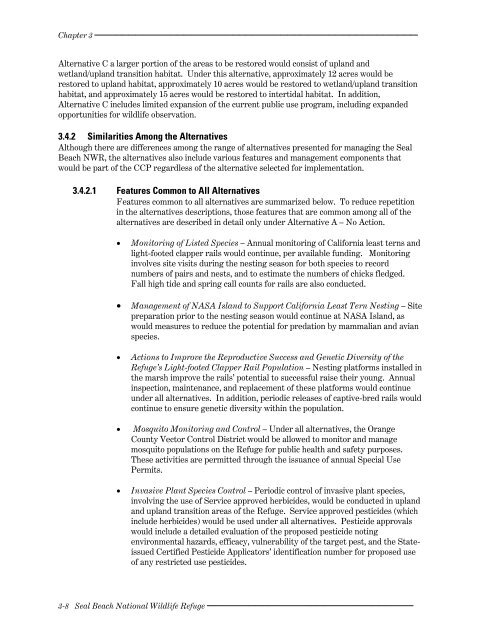Chapters 1 - U.S. Fish and Wildlife Service
Chapters 1 - U.S. Fish and Wildlife Service
Chapters 1 - U.S. Fish and Wildlife Service
You also want an ePaper? Increase the reach of your titles
YUMPU automatically turns print PDFs into web optimized ePapers that Google loves.
Chapter 3 <br />
Alternative C a larger portion of the areas to be restored would consist of upl<strong>and</strong> <strong>and</strong><br />
wetl<strong>and</strong>/upl<strong>and</strong> transition habitat. Under this alternative, approximately 12 acres would be<br />
restored to upl<strong>and</strong> habitat, approximately 10 acres would be restored to wetl<strong>and</strong>/upl<strong>and</strong> transition<br />
habitat, <strong>and</strong> approximately 15 acres would be restored to intertidal habitat. In addition,<br />
Alternative C includes limited expansion of the current public use program, including exp<strong>and</strong>ed<br />
opportunities for wildlife observation.<br />
3.4.2 Similarities Among the Alternatives<br />
Although there are differences among the range of alternatives presented for managing the Seal<br />
Beach NWR, the alternatives also include various features <strong>and</strong> management components that<br />
would be part of the CCP regardless of the alternative selected for implementation.<br />
3.4.2.1 Features Common to All Alternatives<br />
Features common to all alternatives are summarized below. To reduce repetition<br />
in the alternatives descriptions, those features that are common among all of the<br />
alternatives are described in detail only under Alternative A – No Action.<br />
Monitoring of Listed Species – Annual monitoring of California least terns <strong>and</strong><br />
light-footed clapper rails would continue, per available funding. Monitoring<br />
involves site visits during the nesting season for both species to record<br />
numbers of pairs <strong>and</strong> nests, <strong>and</strong> to estimate the numbers of chicks fledged.<br />
Fall high tide <strong>and</strong> spring call counts for rails are also conducted.<br />
Management of NASA Isl<strong>and</strong> to Support California Least Tern Nesting – Site<br />
preparation prior to the nesting season would continue at NASA Isl<strong>and</strong>, as<br />
would measures to reduce the potential for predation by mammalian <strong>and</strong> avian<br />
species.<br />
Actions to Improve the Reproductive Success <strong>and</strong> Genetic Diversity of the<br />
Refuge’s Light-footed Clapper Rail Population – Nesting platforms installed in<br />
the marsh improve the rails’ potential to successful raise their young. Annual<br />
inspection, maintenance, <strong>and</strong> replacement of these platforms would continue<br />
under all alternatives. In addition, periodic releases of captive-bred rails would<br />
continue to ensure genetic diversity within the population.<br />
Mosquito Monitoring <strong>and</strong> Control – Under all alternatives, the Orange<br />
County Vector Control District would be allowed to monitor <strong>and</strong> manage<br />
mosquito populations on the Refuge for public health <strong>and</strong> safety purposes.<br />
These activities are permitted through the issuance of annual Special Use<br />
Permits.<br />
Invasive Plant Species Control – Periodic control of invasive plant species,<br />
involving the use of <strong>Service</strong> approved herbicides, would be conducted in upl<strong>and</strong><br />
<strong>and</strong> upl<strong>and</strong> transition areas of the Refuge. <strong>Service</strong> approved pesticides (which<br />
include herbicides) would be used under all alternatives. Pesticide approvals<br />
would include a detailed evaluation of the proposed pesticide noting<br />
environmental hazards, efficacy, vulnerability of the target pest, <strong>and</strong> the Stateissued<br />
Certified Pesticide Applicators’ identification number for proposed use<br />
of any restricted use pesticides.<br />
3-8 Seal Beach National <strong>Wildlife</strong> Refuge

















